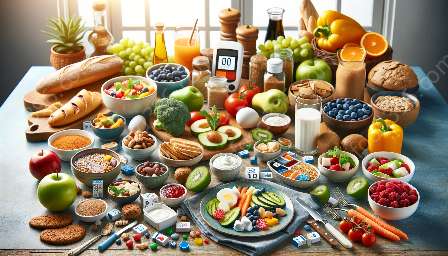When it comes to managing a healthy diet, balancing meals and snacks is crucial to maintain proper nutrition and blood sugar levels. This is especially true for individuals with diabetes who need to be mindful of both portion control and the nutritional content of what they eat. In this comprehensive guide, we will explore the importance of portion control and its relevance to diabetes dietetics while providing real-life tips and advice on how to craft attractive and delicious meals and snacks.
The Importance of Balancing Meals and Snacks
Balancing meals and snacks is essential for overall health and well-being. By incorporating a variety of nutrients into your daily diet, you can support your body's energy needs, promote satiety, and help maintain stable blood sugar levels. For individuals with diabetes, this balance is even more critical, as it directly impacts their blood glucose control and overall health.
Understanding Portion Control
Portion control plays a significant role in balancing meals and snacks. By being mindful of portion sizes, you can better manage your caloric intake and prevent overeating. This is particularly important for individuals with diabetes, as excessive food consumption can lead to spikes in blood sugar levels, which can be dangerous if not managed properly.
The Basics of Portion Control
Portion control involves understanding appropriate serving sizes for different food groups and being conscious of how much you are consuming at each meal and snack. One helpful approach is to use visual cues, such as comparing portion sizes to everyday objects or using measuring cups and scales to accurately portion out food. Additionally, focusing on nutrient-dense, high-fiber foods can help you feel more satisfied with smaller portions, promoting better blood sugar control and overall health.
- Choose whole grains, fruits, vegetables, lean proteins, and healthy fats as the foundation of your meals and snacks.
- Aim to fill half your plate with non-starchy vegetables, a quarter with lean protein, and a quarter with whole grains or starchy vegetables.
- Avoid oversized portions and be mindful of liquid calories from sugary drinks and alcoholic beverages.
Balancing Macronutrients
Another key aspect of balancing meals and snacks is considering the distribution of macronutrients – carbohydrates, proteins, and fats. For individuals with diabetes, this involves managing carbohydrate intake to keep blood sugar levels steady, while also ensuring adequate protein and healthy fats for overall nutrition and satisfaction.
Understanding the Glycemic Index
The glycemic index (GI) is a helpful tool for individuals with diabetes to understand how different carbohydrate-containing foods can impact blood sugar levels. Foods with a low GI, such as most non-starchy vegetables and whole grains, are digested more slowly, leading to gradual rises in blood glucose levels. On the other hand, high-GI foods, like sugary snacks and refined grains, can cause rapid spikes in blood sugar, making portion control and balance even more crucial.
- Focus on including a mix of low to moderate GI foods in your meals and snacks to help sustain energy levels and manage blood sugar.
- Pair carbohydrates with lean protein and healthy fats to slow down digestion and minimize the impact on blood glucose.
Making Meals and Snacks Attractive and Real
Creating visually appealing and delicious meals and snacks is key to enjoying a balanced diet. This can be especially challenging when managing diabetes and portion control, but it's certainly possible with a thoughtful approach to meal planning and preparation.
Flavorful and Nutrient-Rich Options
When crafting meals and snacks, focus on incorporating a variety of flavors and textures using whole, unprocessed ingredients. With a creative combination of herbs, spices, and wholesome foods, you can add depth and richness to your meals without relying on excessive salt, sugar, or unhealthy fats.
- Experiment with fresh herbs, citrus zest, and aromatic spices to enhance the flavors of your dishes without adding extra calories or sodium.
- Include a colorful array of fruits, vegetables, and lean proteins to provide essential nutrients and create visually appealing plates.
Portion-Friendly Presentation
Opt for smaller, attractive serving dishes and utensils to help manage portion sizes and create an inviting dining experience. By presenting your meals and snacks in a visually appealing manner, you can enhance the enjoyment of eating while maintaining portion control.
- Use smaller plates and bowls to naturally limit portion sizes and prevent overeating.
- Arrange your meals in an aesthetically pleasing manner, paying attention to color contrast and food placement to create an appealing presentation.
Real-Life Tips and Advice
Practical strategies can make a significant difference in managing portion control and diabetes dietetics on a day-to-day basis. Consider implementing the following tips to support your efforts in balancing meals and snacks while embracing portion control:
- Plan your meals and snacks in advance, considering portion sizes and nutritional content to align with your diabetes management goals.
- Take time to savor and truly enjoy each bite, focusing on the flavors and textures of your food to promote mindful eating and satisfaction.
- Seek support from a registered dietitian or diabetes educator to receive personalized guidance and meal planning recommendations tailored to your specific needs and preferences.
Conclusion
By understanding the crucial role of balancing meals and snacks, recognizing the importance of portion control, and embracing real-life strategies for meal planning and preparation, individuals can effectively manage their diabetes while enjoying delicious and visually appealing food. With a focus on nutrient-dense, portion-friendly options and mindful eating practices, maintaining a diabetes-friendly diet becomes both achievable and enjoyable.

